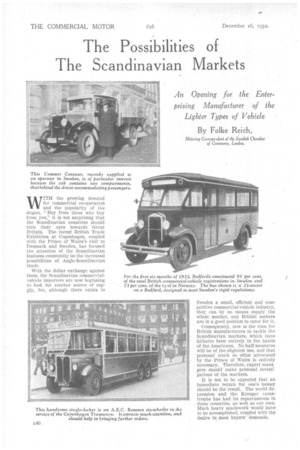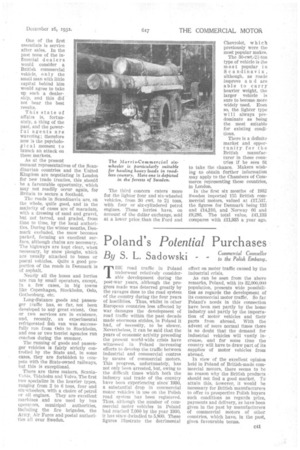The Possibilities of The Scandinavian Markets
Page 86

Page 87

If you've noticed an error in this article please click here to report it so we can fix it.
An Opening for the Enter-, prising Manufacturer of the Lighter Types of Vehicle By Folke Reich,
Motoring Correspoident of the Swedish Chamber of Commerce, London.
WITH the growing demand for commercial co-operation and the popularity of the slogan, "Buy from those who buy from you," it is not surprising that the Scandinavian countries should turn their eyes towards Great Britain. The recent British Trade Exhibition at Copenhagen, coupled with the Prince of WaleS'svisit to Denmark and Sweden, has focused the attention of the Scandinavian business community on the increased possibilities of Anglo-Scandinavian trade.
With the dollar exchange against them, the Scandinavian commercialvehicle importers are now beginning to look for another source of supply, for, although there exists in Sweden a small, efficient and competitive commercial-vehicle industry, they can by no means supply the whole market, and British makers are in a good position to cater for it.
Consequently, now is the time for British manufacturers to tackle the Scandinavian markets, which have hitherto been entirely in the hands of the Americans. No half measures will be of the slightest use, and that personal touch so often advocated by the Prince of Wales is entirely necessary. Therefore, export mana gers should make personal investi gations Of the markets.
It is not to be expected that an immediate return for one's money should be the result. The world depression and the Kreuger catastrophe has had its repercussions in these countries, as well as our own.Much heavy spadework would have to be accomplished, coupled with the desire to meet buyers' demands. One of the first essentials is service after sales. In the past none of the influential dealers would consider a British commercial vehicle, o n 1 y the small man with little capital behind him would agree to take up such a dealership, and this did not bear the best results.
This state of affairs is, fortunately, a thing of the past, and the powerful agents are wavering ; therefore now is the psychological moment to launch an attack on these markets.
As at the present moment representatives of the Scandinavian countries and the United Kingdom are negotiating in London for new trade treaties, this should be a favourable opportunity: which may not readily occur again, for Britain to secure a foothold.
The roads in Scandinavia -are, on the whole, quite good, and in the majority of cases are of macadam, with a dressing of sand and gravel, but not tarred, and graded, from time to time, by the localauthorities. During the winter months, Denmark excluded, the snow becomes packed, forming an excellent surface, although chains are necessary. The highways are kept clear, when necessary, by snow ploughs, which are usually attached to buses or postal vehicles. Quite a good proportion of the roads in Denmark is of asphalt.
Nearly all the buses and lorries are run by small operators, except, in a few eases, in big towns like Copenhagen, Stockholm, Oslo, Gothenburg, etc.
Long-distance goods and passenger traffic has, so far, not been developed to any great extent. One or two services are in existence, and, recently, an experimental refrigerated fish van was successfully run from 0s10 to Stockholm, and one or two tourist agencies run coaches during the summer.
The running of goods and passenger vehicles is fairly strictly controlled by the State and, in some cases, they are forbidden to conspete with the State-owned railways, but this is exceptional.
There are three makers, Scaniava his, Tidaholm and Volvo. The first two specialize in the heavier types, ranging from 2 to 6 tons, four and six-wheelers, with a choice of petrol or oil engines. They are excellent machines and are used by bus operators, municipal authorities, including the fire brigades, the Army, Air Force and postal authorities all over Sweden.
The third concern caters more for the lighter four and six-wheeled vehicles, from 30 cwt. to 2i tons, with four or six-cylindered petrol engines. These lorries have, on account of the dollar exchange, sold at a lower price.than the Ford and
Chevrolet, which previously were the most popular makes.
The 30-cwt.-21-ton type of vehicle is the most popular in Scandinavia, although, as roads improve a n d are able to carry heavier weight, the larger vehicle is sure to become more widely used. Even so, the lighter type will always predominate as being the most suitable for existing conditions.
There is a definite market and opportunity for the British manufac turer in these coun tries if be sees fit to take the chance. Makers wishing to obtain further information spay apply to the Chambers of Commerce representing these countries, in London.
In the first six months of 1932 Sweden imported 155 British commercial motors, valued at £17,5:-17. the figures for Denmark being 133 and £14,310, and Norway 66 and £9,286. The total value, £41,133 compares with £11,935 a year ago.




























































































































































